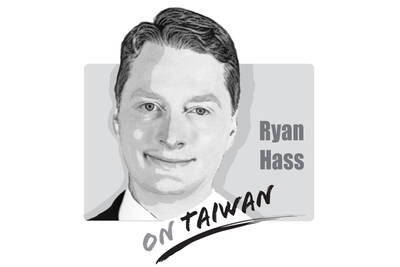In a speech on Oct. 23, Chinese Nationalist Party (KMT) Chairman Johnny Chiang (江啟臣) expressed the hope that the celebration of Retrocession Day would allow people to discuss and review the relationship between the Republic of China (ROC) and Taiwan, adding that the continued existence of the ROC is the only way to curb Taiwanese independence.
It is pretty obvious that all the talk about discussing and reviewing the relationship is just a smokescreen, and that the KMT’s main focus is to curb Taiwanese independence and safeguard the ROC.
This is made even clearer by the fact that ever since KMT caucus whip Lin Wei-chou’s (林為洲) proposal that the word “Chinese” be removed from the party’s name met with strong internal opposition, Chiang has been at pains to distance himself from it.
A Taiwan Thinktank survey released on Sept. 24 regarding the push for normalization of the nation’s status showed that when asked about their national identity and to choose between Taiwanese or Chinese, up to 86 percent identified as Taiwanese.
Another survey released last month showed that if China were to invade Taiwan, 77.6 percent of respondents said they would be willing to fight for Taiwan.
Taiwan Thinktank deputy executive-general Doong Sy-chi (董思齊) said that three transitions of power have shaped people’s national identity, and a public consensus has gradually formed behind the Taiwanese identity.
KMT politicians are also well aware of the process leading to the formation of this Taiwanese identity, but they stubbornly cling onto the Chinese mindset that “one would rather lose one’s property to an outsider than one’s own servant.”
Their practice of shortening the “Republic of China” to “China” has created a natural connection to the Chinese Communist Party’s (CCP) view that Taiwan is part of China.
Of course the ROC’s dependence on Taiwan has created division and opposition between the two.
Unfortunately, the KMT’s insistence on the ROC’s existence has led to a political farce and constant conflict between the pan-blue and pan-green camps. The problem has divided our nation, land and people, while distorting our education system and character, making it difficult for teachers to explain to the next generation what our nation is and where it is located.
Since the nation has been separated from the land and its people, this abnormal ideology has made it very difficult to shape our own culture and that is why spiritually, many Taiwanese either display a “colonial mentality” or a “refugee culture.” This is the real tragedy of Taiwanese.
How will the KMT define Taiwan?
Chiang recently asked some young people: “What do we think? What will we do? What future direction do we want for our nation and society?”
The way he set it up, it sounded as if he were going to make a significant declaration, but the answer he gave was simply this: “We want Taiwanese independence supporters to go to President Tsai Ing-wen (蔡英文) and ROC supporters to come to us.”
It was dumbfounding.
The KMT has been lying ever since its came to Taiwan. Following former KMT chairman Ma Ying-jeou’s (馬英九) lie about the so-called “1992 consensus” and “one China, with each side having its own interpretation,” Chiang has now proposed the KMT’s future direction for Taiwan.
What is he playing at? Is he really going to try to eliminate Taiwanese independence and continue to deceive Taiwanese?
Chen Ching-kuen is an assistant professor.
Translated by Eddy Chang

There has been much catastrophizing in Taiwan recently about America becoming more unreliable as a bulwark against Chinese pressure. Some of this has been sparked by debates in Washington about whether the United States should defend Taiwan in event of conflict. There also were understandable anxieties about whether President Trump would sacrifice Taiwan’s interests for a trade deal when he sat down with President Xi (習近平) in late October. On top of that, Taiwan’s opposition political leaders have sought to score political points by attacking the Lai (賴清德) administration for mishandling relations with the United States. Part of this budding anxiety
The diplomatic dispute between China and Japan over Japanese Prime Minister Sanae Takaichi’s comments in the Japanese Diet continues to escalate. In a letter to UN Secretary-General Antonio Guterres, China’s UN Ambassador Fu Cong (傅聰) wrote that, “if Japan dares to attempt an armed intervention in the cross-Strait situation, it would be an act of aggression.” There was no indication that Fu was aware of the irony implicit in the complaint. Until this point, Beijing had limited its remonstrations to diplomatic summonses and weaponization of economic levers, such as banning Japanese seafood imports, discouraging Chinese from traveling to Japan or issuing
On Nov. 8, newly elected Chinese Nationalist Party (KMT) Chairwoman Cheng Li-wun (鄭麗文) and Vice Chairman Chi Lin-len (季麟連) attended a memorial for White Terror era victims, during which convicted Chinese Communist Party (CCP) spies such as Wu Shi (吳石) were also honored. Cheng’s participation in the ceremony, which she said was part of her efforts to promote cross-strait reconciliation, has trapped herself and her party into the KMT’s dark past, and risks putting the party back on its old disastrous road. Wu, a lieutenant general who was the Ministry of National Defense’s deputy chief of the general staff, was recruited
The Food and Drug Administration (FDA) on Nov. 5 recalled more than 150,000 eggs found to contain three times the legal limit of the pesticide metabolite fipronil-sulfone. Nearly half of the 1,169 affected egg cartons, which had been distributed across 10 districts, had already been sold. Using the new traceability system, officials quickly urged the public to avoid consuming eggs with the traceability code “I47045,” while the remainder were successfully recalled. Changhua County’s Wenya Farm — the source of the tainted eggs — was fined NT$120,000, and the Ministry of Agriculture instructed the county’s Animal Disease Control Center to require that